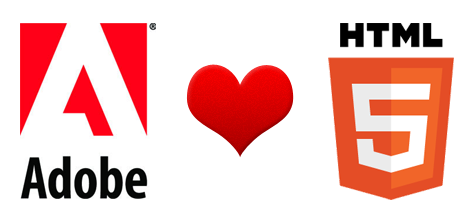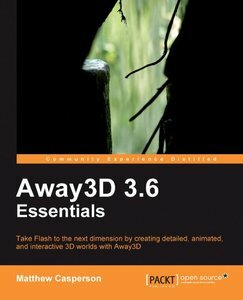Adobe Acquires Nitobi
So if you haven’t heard yet, Adobe acquired Nitobi, the company that is responsible for PhoneGap. This was announced at Adobe’s big MAX conference. If you are unfamiliar with PhoneGap, then this post is going to be wildly uninteresting to you. At a high level, they provide a cross platform mobile development solution that leverages native webviews with HTML5, CSS, and Javascript to create native mobile apps.
Not Hard To See Coming
Well, for one thing, Adobe was obviously hedging its bets on Flash/Air’s viability in the long term with mobile when they started introducing HTML5 capabilities through Edge. I mean, if Adobe’s planning to offer interactive, Flash-like development with HTML5, who is going to believe that Flash itself has a real future with mobile? Or as Gizmodo put it, Adobe Edge may become the beginning of the end for Flash. Yeah, it will likely always exist, but it is not the de facto standard for delivering interactive web (or mobile) content anymore.
And of course there’s the whole Adobe Air for mobile thing. Android was obliging enough to make Air a first class citizen. Install Air, run Air apps… simple. And while the Adobe Air install is a bit hefty, it’s hardly something worth worrying about with today’s storage capabilities on mobile devices.
“Flash has been labeled an outlaw and Air is smuggled in like an illegal immigrant”
The more harrowing journey for Adobe has been iOS. Basically, Flash has been labeled an outlaw and Air is smuggled in like an illegal immigrant. There’s been a staring contest between Adobe and Apple for a while now, but I think it’s safe to say Adobe blinked. Apple has continually proven that is has the most marketable mobile devices available, and has done so without any back pedaling on what they will and will not allow (minus letting 3rd parties build apps).
Something had to give if Adobe was going to get a real foothold in the mobile world, and it obviously wasn’t coming in the form of their current solutions. Enter PhoneGap…
But PhoneGap is not Without Its Challenges
 |
| Image by |
PhoneGap fills a lot of holes for Adobe, but its going to need a lot of help itself. I think PhoneGap has gone about as far as it can on its own. It has achieved its goal of abstracting most native functionality for many different mobile platforms, but starting developers are wanting more.
PhoneGap has no user interface components. This is not fun for new developers… or veteran ones for that matter. You need to build everything from scratch or go out and find a UI framework that works for you. The 2 front-runners, Sencha Touch and jQuery Mobile, bring their own glitches and idiosyncrasies. Also, now you find yourself learning 2 frameworks that have a noticeable lack of cross-over documentation.
There’s also a seemingly purposeful lack of direction in terms of tooling and best practices. New developers, often web developers, are left to their own devices to find the workflow that works best for them. There’s no sanctioned IDE or set of tools suggested from PhoneGap to build your mobile apps. Infinite flexibility can be a real drag when you just want to know the most effective way to get things done.
But let’s put this even more plainly…
What are the pros and cons of PhoneGap?
| Pros | Cons |
|
|
And what are the pros and cons of Adobe?
| Pros | Cons |
|
|
Anyone else seeing a pretty clear yin-yang thing going on here?
So What Does It All Mean?
Well, for one thing, it means PhoneGap is becoming an Apache project. Yep, they are donating PhoneGap to Apache, which puts them one step closer to their altruistic goal of PhoneGap itself becoming obsolete. PhoneGap’s own Brian Leroux stated in his PhoneGap 1.0 presentation that:
“The purpose of PhoneGap is for PhoneGap to cease to exist”
Why, oh why, did Adobe buy it then? I think it’s because they want to be your one stop shop for purchasing IDEs, frameworks, professional services, etc… Adobe is likely banking on the ongoing popularity of PhoneGap and web-based native mobile development. “Web-based native”… sounds a little like an oxymoron, but whatever.
A Match Made in Heaven, Right?
Sounds like a perfect match. The 2 companies seem to complement each other very well. But…
There’s just a few questions I still have regarding the acquisition. Rather than drone on any longer inserting my own conjecture, I’ll just list my questions here and leave them as talking points for you, my readers.
“I can already hear the `It’s back to AS1` complaints starting…”
- What happens to Flash/Air for mobile? It obviously won’t be forsaken, but this can’t sit real well with developers who have so far devoted themselves to this workflow.
- How does Adobe deal with the inevitability that current developers will revolt against using Javascript? I can already hear the “It’s back to AS1″ complaints starting…
- Does Adobe even have any interest in getting existing AS3 developers using PhoneGap? I know they are saying that they weill support both solutions, but come on, someone is gonna get more love than the other.
- How long until we finally see a defined workflow and IDE for PhoneGap. Is Dreamweaver integration the best we get?
- What will the PhoneGap guys do next? They are actively working to put themselves out of a job, so I’m curious what the next move is.
What’s Next?
I have no clue, but it’s sure to be interesting. I’m hoping for good things on both sides as it’s only going to make mobile development in general more exciting.

Will Adobe’s ability to create great tools translate to mobile success? Will PhoneGap’s strict adherence to the open web model jive well with Adobe’s history of closed, proprietary tools? Will the inevitable merge of the open web and existing Adobe community be a bumpy one?
Stay tuned…








One thing that can be argued about in your post is the emphasis on “Adobe will chose ONE horse to bet on”.
I think Adobe want to be the “multi platform, multi screen” company. They don’t care if it’s with AS3 or JS, Flash/Flex or HTML.
They just want devs to think: “If I chose multi over native, Adobe has the right tools for me”.
For example, it’s what they’ve done for the web for years now.
Of course, everybody think about Adobe when you say Flash.
But, what is the most used HTML design tool? Adobe’s Dreamweaver.
Their goal: “you want to design for the web, go Adobe, whatever you use”.
They also haven’t chosen between bitmap graphics (Photoshop) and vectors one (Illustrator + Fireworks).
Again, “we don’t care what’s your religion, as soon as you pass by the Adobe design temple.”
Of course, I’m not blind. Adobe has “limited” resources, and maybe part of the money they’ll put on PhoneGap will be subtracted from the AIR mobile effort.
But I think their ultimate goals is to make multi-platform development seen as a viable option, and the preferred one for as many use cases as possible, and to be sure their tools are the best for this kind of jobs.
To be able to attracts ALL web developers, without forcing them to learn a new language, makes a lot of sense when you are the de facto web tools company.
For what it worth, I’m more worried about Flex in the browser than I am about Flex in apps.
Adobe has clearly chosen to bet more on the latter for the future of Flex…
In my opinion Flex/AIR brings a lot more to the table than just access to Mobile.
PhoneGap does make targeting multiple MOBILE platforms accessible with just web design and development skills, and that has been, and will be attractive to a lot of people.
Flex/AIR allows developers (willing to learn MXML and AS3) to target Desktops, Browsers, and Mobile platforms with one code base. With features like Native Extensions the level of integration on Desktop and Mobile has just gotten much deeper.
What PhoneGap will do is prevent Flex/AIR from being used in places it was not needed to begin with. Flex/AIR will not be the immediate solution to all Mobile Apps, just like Flash is no longer the immediate solution for all cool looking interactive websites because of the new HTML5 religion … I mean technology.
I see Flex/Air making its way more to the enterprise where solutions need to work on several devices (including desktops) in similar fashion. I see it drawing more of a following from programmers who want to leverage “write once, run anywhere”.
The future belongs to the technology agnostic. The more tools you can use, the better choices you can make as to which fits the current need. Adobe understands that, I don’t see them dropping any of their products in favor of new ones … just my opinion.
“The future belongs to the technology agnostic”… I couldn’t agree more.
Nice reading. There’s a lot to say about this.
I will try to be straightforward with this.
I rather use AIR over PhoneGap because of the platform advantages.
And Adobe are my heroes because they know how to be plain neutral and give support to the “hip” platforms around. Whichever “wins” the competition, Adobe is supporting it right now.
So we developers can just use whatever we like or whatever the market needs and be happy
Nitobi is a private company so I don’t think there will be a report on how much Adobe paid for them. Probably chump change in the whole scheme of things. But what does Adobe get out of it? I think they get two things:
1-PhoneGap. So far everyone is focused on the developer/technical story. But the purchase obviously sends a loud message to Wall Street that Adobe is playing both sides of the fence. Wall Street types don’t know dick about HTML or Flash but they hear HTML all the time. If nothing else this is just good PR for a company that can really use it.
2-Employees. Nitobi obviously has some top notch developers on the team and those are hard to find. It will be interesting to see what happens with Nitobi over the next few years. Maybe the talent will erode away but if they stay then it can only be a positive for Adobe.
In the post you mentioned that Adobe and Apple were in a staring contest and Adobe blinked. I don’t see it that way. Apple had refused to allow VMs on their devices and then they reversed course. Isn’t it Apple who blinked?
You could say it was Adobe who blinked if your considering the captive runtime solution to publishing to iOS but that is just a technical fix to a problem. Now captive runtime is available for Android as well – I’m tempted to use it for the RunPee app.
Anyhow, good writeup on the PhoneGap stuff. I learned a lot about what it is and how it works. Sounds like it is very useful but a PITA to develop with. I think I’ll stick with AIR. I’m so happy we have Native Extensions now. It’s a life saver.
I’m always impressed by your analyses.
I think you’re mostly right for HTML5 development getting advantage on AIR in the long run for “web native apps”. Though it doesn’t please me (just writteen a book on this topic, deprecated before parution?). But for Adobe no concern, they have already started the shift for replacement tool.
I think one must still make a difference between Flash, Flex and AIR.
Flash usage in the browser as we knew it, will be progressively replaced y HTML5.
But Adobe bets that *Flash for mutiplatform game development* can still represent a very important source of revenue. This is the strong message of last Adobe MAX conference. It doesn’t comfort me as I’m not a Flash nor a game developer.
Then you’ve got Flex and MXML, pretty good SDK and efficient *declarative* language. Their future in the browser is sunking since MAX 2010.
But I think that if they disappear there will still be a hole to fill for a modern, efficient multiplatform develoment environment. There is still an interest for declarative approach.
Microsoft have tried and fail with Silverlight, Adobe may have failed too with Flex, Java didn’t succeed either with Java then JavaFx. Google is always trying to imagine something to go ahead of HTML-JS.
And you’ve got the server-side part.
The Cloud will change again the context. See what’s coming with databases in the cloud. See what Salesforce is trying to conceive…
I think that business app developers still need a modern solution.
What will it be? Honestly, I don’t know…
“Weak mobile platform compatibility. Android made Air a first class citizen, but we all know the story with iOS.”
It’s weak in that Flash can’t run on Safari mobile, but few are making web-based Flash/Flex apps, it’s mainly AIR apps. With AIR 2.7 Adobe managed to get performance of AIR on iOS very close to Android. There are still some things that I hear now and again from developers that are a bit faster on one platform or another, but features and performance are for the most part on par across both platforms.
The fact that Apple has been promoting AIR apps and that a number of AIR apps have topped the iTunes App Store charts, shows that Apple isn’t holding back any bad blood but has moved on.
“The majority of Adobe’s tools and SDKs are closed and proprietary”
Adobe’s tools are closed, but their SDKs are open allowing others to make their own tools.
The fact that the majority of Adobe’s new tablet apps are made with Adobe AIR, especially Photoshop Touch shows Adobe’s commitment to the platform. In the Flash Platform roadmap session at MAX showed how Adobe will continue to invest heavily in the platform. They are even looking to have the incubator builds move up to monthly, weekly and daily builds.
What I think Adobe wants from Nitobi is better integration with Dreamweaver. They already had initial support targeting Android and iOS apps for PhoneGab, but they want more. Also with Adobe making a push into the cloud and likes Nitobi’s PhoneGab Build solution:
https://build.phonegap.com/
Which is one of the few commercial properties that Adobe was actually buying when they bought Nitobi.
“How does Adobe deal with the inevitability that current developers will revolt against using Javascript?”
Adobe actually does have a community of web developers who use Dreamweaver and I think those are the ones they are targeting with this, rather than getting all of their Flash/Flex developers to switch. Long before Edge (which while HTML5 makes great marketing, is really just HTML4 content & moving DIVs around) Adobe had created an open source AJAX framework called Spry. They have since abandoned Spry and are instead contributing to jQuerry & jQuerry mobile, Adobe has always invested in HTML, it’s just never been a big tech news story until HTML5.
Hey Tony, like the article. Lets see if I can answer your q’s.
What happens to Flash/Air for mobile? * It will keep evolving but w/ the Nitobi influence in house. Adobe is smart enough to have more than one bet on web technology.
How does Adobe deal with the inevitability that current developers will revolt against using Javascript? * I see not revolt but rather a growing realization that JS isn’t so bad after all. Again, its not an exclusion situation.
Does Adobe even have any interest in getting existing AS3 developers using PhoneGap? I know they are saying that they weill support both solutions, but come on, someone is gonna get more love than the other. * Not at all. The Nitobi team will continue working on PhoneGap and the developers working on Flash ecosystem willl work on that. Adobe is big. They have great people and they can execute for more than one audience/strategy. That said, developers focused solely on ActionScript and the like are very likely investigating HTML5. Adobe is there too.
How long until we finally see a defined workflow and IDE for PhoneGap. Is Dreamweaver integration the best we get? * IDE support for PhoneGap already exists if thats what need. Eclipse. Dreamweaver. Visual Studio. TextMate. VIM. Emacs. Sublime. All very good HTML editors.
What will the PhoneGap guys do next? They are actively working to put themselves out of a job, so I’m curious what the next move is. * We’ll continue contributing back to the open mobile web. The sentiment that PhoneGap should cease to exist is one that describes a future of more powerful web browsers, browsers that support device apis, rather than a future wherein we are jobless.
@Juan: You think it’s just support for “hip” platforms. There’s obviously a bigger picture here that hasn’t been revealed yet.
@Brian: Thanks for dropping in and clearing up some of those hanging questions I had at the end. So if I’m understanding you right, with regards to the IDE situation, there still will likely be no “defined” route for PhoneGap development? It wil still be the tool of your choice in whatever capacity it integrated PhoneGap?
Well, we’re always going to keep improving our tooling for sure. Choice in editor tooling is certainly in my personal philosophy though I think you can count on us having really great support in Dreamweaver in the coming year for sure. =)